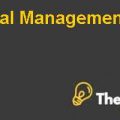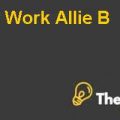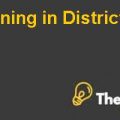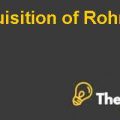Kraft Heinz Case Study Solution
Synergies
The expected synergies that have been gained from the acquisition of both of the companies are: increase in sales, reduction in expenses, achievement of economies of scale and better presence in the international market. However, in the recent years of merger, the company has a big jump in the sales with the reduction in expenses, but the company hasn’t performed well during 2018. The company recorded a net loss in the following year with the aim to reduce the expenses, the company terminated its employees. Additionally, due to an intense competition and for fulfilling the aim of reduction in cost, the company forgot to deliver the tasty food, due to which the company recorded loss in 2018. According to some investors and 3G and BH paid overvalued to the Kraft, because the synergies that were expected from the merger are not fulfilled yet.(Plat, 2019).
Current Strategy
The current strategy of the company is to expand its expansion internationality, improve its reputation and brand image, drive revenue growth and increase its market share by attracting more consumers and maintaining a long term relationship with them. However, the company may not be able to execute the international expansion strategy successfully, due to the changes in consumers’ demands, preferences or tastes and purchasing trend in international market. Additionally, the company is facing anintense competition in the international market due to which company has been faced with numerous difficulties in integratingthe foreign business operations with current resources, which include:distribution channels, sourcing and informationtechnology.(Officals, The Kraft Heinz Company, 2018)
The company would have to improve its relationship at each level of its supply chain in order to better execute its current strategy, and to facilitate its customers more efficiently. Additionally, it is recommended for the company to manage different operationseffectively. The company should add products in its portfolio in order to eliminate the cannibalization. Furthermore, in order to remain profitable and to reverse its stock prices the company would have to use different growth strategies such as market development and product development with the aim of improving consumer base, revenues and profitability. The company also performs merger with those companies who already operate in different markets. This would help the company to gain its foot prints in international market and to reduce the threat of competitions. In union, with the aim cutting the operational cost the company would forget to make food tastier. The company must have to develop new taste for the customer which help them to stay loyal and maintain long term relationship with them.
Exhibit-1: Forecasted Synergies
| Forecasted | ||||||
| 2014 | 2015 | 2016 | 2017 | 2018 | ||
| Sales | 28,276 | 30,538 | 32,981 | 35,619 | 35,619 | |
| Cost of products sold | 19,750 | 70% | 20,109 | 21,717 | 23,455 | 23,455 |
| Gross profit | 8,526 | 30% | 10,429 | 11,264 | 12,165 | 12,165 |
| Selling, general and administrative expenses | 5,068 | 18% | 4,252 | 4,592 | 4,959 | 4,959 |
| Operating income | 3,458 | 12% | 6,178 | 6,672 | 7,206 | 7,206 |
| Interest income | 42 | 0% | 42 | 42 | 42 | 42 |
| Interest expense | 849 | 3% | 371 | 401 | 433 | 433 |
| Other expense, net | 28 | 0% | 30 | 32 | 35 | 35 |
| Income from continuing operations before income taxes | 2,624 | 9% | 5,818 | 6,280 | 6,779 | 6,779 |
| Provision for income taxes | 736 | 3% | 1,513 | 1,633 | 1,763 | 1,763 |
| Income from continuing operations | 845 | 3% | 4,306 | 4,647 | 5,017 | 5,017 |
| Net income | 1,888 | 7% | 4,306 | 4,647 | 5,017 | 5,017 |
Exhibit-2: Actual Synergies
| Breakdown | TTM | 2018 | 2017 | 2016 | 2015 |
| Total Revenue | 25,332,000 | 26.259.000 | 26.085,000 | 26.487.000 | 18.338,000 |
| Cost of Revenue | 17.076,000 | 17.309.000 | 16.948,000 | 16.901.000 | 12.577,000 |
| Gross Profit | 8.256,000 | 8.950.000 | 9.137,000 | 9.586.000 | 5.761,000 |
| Selling General and Administrative | 3.223,000 | 3.204,000 | 3.000,000 | 3.444,000 | 3.122,000 |
| Total Operating Expenses | 3.223,000 | 3.204,000 | 3.000,000 | 3.444,000 | 3.122,000 |
| Operating Income or Loss | 5.033,000 | 5.746,000 | 6.137,000 | 6.142,000 | 2.639,000 |
| Interest Expense | 1.360,000 | 1.288.000 | 1.234,000 | 1.134,000 | 1.321,000 |
| Total Other Income/Expenses Net | -15.813,000 | -15.756.000 | 627,000 | 15 | -305,000 |
| Income Before Tax | -12.140,000 | -11.298.000 | 5.530,000 | 5.023.000 | 1.013,000 |
| Income Tax Expense | -1,262 | 1,006 | -5.460,000 | 1.381.000 | 366,000 |
| Income from Continuing Operations | -10.878,000 | -10.292.000 | 10.990,000 | 3.642.000 | 647,000 |
| Net Income | -10.815,000 | -10.229.000 | 10.999,000 | 3.632.000 | 634,000 |
| Net Income available to common s… | -10.815,000 | -10.229.000 | 10.999,000 | 3.452.000 | -266,000 |
| Reported EPS | |||||
| Basic | -8.39 | 9.03 | 2.84 | -0.34 | |
| Diluted | -8.39 | 8.95 | 2.81 | -0.34 |
Exhibit-3: Heinz WACC
| Tax Rate | 30.62% |
| Interest rate | 0.01% |
| Total Debt | 4,730,946 |
| Total Equity | 1,887,820 |
| Competitors Beta | 2.53 |
| Competitors Tax Rate | 22% |
| Competitors Debt to Equity Ratio | 2.88 |
| Unlevered Beta | 0.78 |
| Levered Beta | 2.13 |
| Risk Free Rate | 2% |
| Market Risk Premium | 4% |
| Equity Return | 10.54% |
| Equity Weight | 0.29 |
| Debt Weight | 0.71 |
| WACC | 3.01% |
Exhibit-4: Kraft’s WACC
| Beta | 0.32488154 |
| Interest Rate | 6% |
| Total Debt | 8627 |
| Total Equity | 4365 |
| Rf | 2% |
| Total Assests | 12992 |
| Risk Premium | 4% |
| Weight of Debt | 66% |
| Weight of Equity | 34% |
| Tax Rate | 26% |
| CAPM | 3.1% |
| WACC | 3.82% |
This is just a sample partical work. Please place the order on the website to get your own originally done case solution.
How We Work?
Just email us your case materials and instructions to order@thecasesolutions.com and confirm your order by making the payment here











